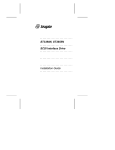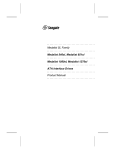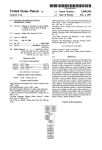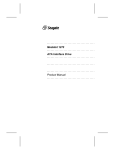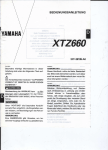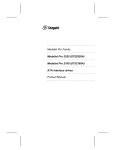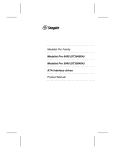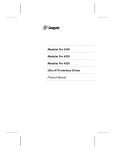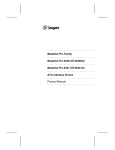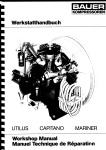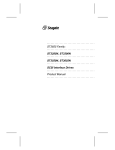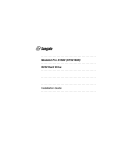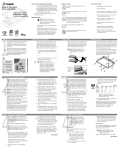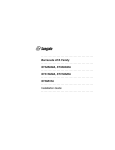Download Seagate ST5660A Product manual
Transcript
..................................... ST5660A ..................................... AT Interface Drive ..................................... ..................................... ..................................... Product Manual ..................................... ..................................... ST5660A ..................................... AT Interface Drive ..................................... ..................................... ..................................... Product Manual ..................................... © 1994 Seagate Technology, Inc. All rights reserved Publication Number: 36242-001, Rev. A March 1994 Seagate®, Seagate Technology® and the Seagate logo are registered trademarks of Seagate Technology, Inc. Other product names are trademarks or registered trademarks of their owners. Seagate reserves the right to change, without notice, product offerings or specifications. No part of this publication may be reproduced in any form without written permission from Seagate Technology, Inc. ST5660A Product Manual, Rev. A iii Contents 1.0 Specifications . . . . . . . . . . . . . . . . . . . . . . . . . . 1 1.1 Formatted capacity . . . . . . . . . . . . . . . . . . . . . . 1 1.2 Functional specifications . . . . . . . . . . . . . . . . . . . 2 1.2.1 Seek time . . . . . . . . . . . . . . . . . . . . . . . . . 2 1.2.2 Multisegmented cache buffer . . . . . . . . . . . . . . . 3 1.3 Start/stop time . . . . . . . . . . . . . . . . . . . . . . . . . 3 1.4 Typical power-up and power-down sequence . . . . . . . . . 3 1.4.1 Power-up sequence . . . . . . . . . . . . . . . . . . . 3 1.4.2 Power-down sequence . . . . . . . . . . . . . . . . . . 4 1.4.3 Auto-park . . . . . . . . . . . . . . . . . . . . . . . . . 4 1.5 Reliability . . . . . . . . . . . . . . . . . . . . . . . . . . . 4 1.6 Physical dimensions . . . . . . . . . . . . . . . . . . . . . 4 1.7 Environmental specifications . . . . . . . . . . . . . . . . . 5 1.7.1 Ambient temperature . . . . . . . . . . . . . . . . . . . 5 1.7.2 Temperature gradient . . . . . . . . . . . . . . . . . . 5 1.7.3 Relative humidity . . . . . . . . . . . . . . . . . . . . . 5 1.7.4 Altitude . . . . . . . . . . . . . . . . . . . . . . . . . . 5 1.7.5 Acoustics . . . . . . . . . . . . . . . . . . . . . . . . . 5 1.8 Shock and vibration . . . . . . . . . . . . . . . . . . . . . . 6 1.9 DC power . . . . . . . . . . . . . . . . . . . . . . . . . . . 6 1.9.1 Input noise . . . . . . . . . . . . . . . . . . . . . . . . 6 1.9.2 Power management . . . . . . . . . . . . . . . . . . . 7 1.9.3 Power consumption . . . . . . . . . . . . . . . . . . . 9 1.10 Agency listings . . . . . . . . . . . . . . . . . . . . . . . 11 1.11 FCC verification . . . . . . . . . . . . . . . . . . . . . . 11 2.0 Configuring and mounting the drive . . . . . . . . . . . . . 13 2.1 Handling and static-discharge precautions . . . . . . . . . 13 2.2 I/O cable and connector . . . . . . . . . . . . . . . . . . 14 iv ST5660A Product Manual, Rev. A 2.3 Remote LED connection . . . . . . . . . . . . . . . . . . . 14 2.4 Jumpers . . . . . . . . . . . . . . . . . . . . . . . . . . . 15 2.4.1 Jumper sizes . . . . . . . . . . . . . . . . . . . . . . 15 2.4.2 Master/slave configuration . . . . . . . . . . . . . . . 15 2.5 Cable select option . . . . . . . . . . . . . . . . . . . . . . 17 2.6 Mounting the drive . . . . . . . . . . . . . . . . . . . . . . 18 3.0 AT interface . . . . . . . . . . . . . . . . . . . . . . . . . . 21 3.1 ST5660A commands . . . . . . . . . . . . . . . . . . . . . 21 3.1.1 Identify Drive command (ECH) . . . . . . . . . . . . . 23 3.1.2 Set Features command (EFH) . . . . . . . . . . . . . 25 3.1.3 Sleep command (99H, E6H) . . . . . . . . . . . . . . . 25 3.2 Interface connector pin assignments . . . . . . . . . . . . 25 Appendix. Timing diagrams . . . . . . . . . . . . . . . . . . . . . 27 ST5660A Product Manual, Rev. A v Figures Figure 1. Typical startup current profile . . . . . . . . . . . . . . . 10 Figure 2. AT interface connector . . . . . . . . . . . . . . . . . . 14 Figure 3. Configuration jumpers . . . . . . . . . . . . . . . . . . 16 Figure 4. Connecting cable-selected drives . . . . . . . . . . . . . 17 Figure 5. Mounting dimensions . . . . . . . . . . . . . . . . . . . 19 Figure 6. AT interface connector pin assignments . . . . . . . . . 26 Figure 7. Programmed I/O timing without IORDY . . . . . . . . . . 27 Figure 8. Programmed I/O timing with IORDY . . . . . . . . . . . 28 Figure 9. Multiword DMA timing . . . . . . . . . . . . . . . . . . . 29 ST5660A Product Manual, Rev. A 1 1.0 Specifications 1.1 Formatted capacity The drive was low-level formatted at the factory—you cannot low-level format it. You can operate the drive using many different logical configurations, provided the number of sectors per track does not exceed 63. Three possible configurations are shown below. The first two configurations represent conventional CHS addressing as used on most DOS computers. The third configuration uses LBA addressing. CHS CHS* LBA** Cylinders 1,024 1,057 N/A Heads 16 16 N/A Sectors 63 63 N/A Total sectors 1,032,192 1,065,456 1,066,184 545.3 545.8 Formatted capacity (Mbytes***) 528.48 * This is the default configuration. This configuration can only be used in computers that are capable of addressing more than 1,024 cylinders. Therefore, if your computer cannot address more than 1,024 cylinders, you must change the configuration using the setup utility. ** This configuration can only be used in computers that support LBA addressing. ***One megabyte equals one million bytes. The drive was configured in translation mode at the factory. You can verify the number of cylinders, sectors per track and heads and the total number of LBA sectors by using the Identify Drive (ECH) command. See Section 3.1.1 for details about the Identify Drive command. 2 ST5660A Product Manual, Rev. A 1.2 Functional specifications Interface AT (IDE) Zone Bit Recording method RLL (1,7) External data burst transfer rate (Mbytes per sec) 11.1* 13** Internal data transfer rate (Mbits per sec) 27 to 48 Spindle speed (RPM) 4,500 ± 0.5% Cache size (Kbytes) 256 Read/write heads 4 Discs 2 Bytes per sector 512 Recording density, max (BPI) 68,000 Track density (TPI) 3,309 * This is the external transfer rate using PIO mode 3 timing. ** This is the external transfer rate using multiword DMA mode 1 timing. 1.2.1 Seek time Seek time is measured under nominal conditions of temperature and voltage with the drive mounted horizontally. Seek time is a true statistical average of at least 5,000 seeks. Track-to-track seek time is the average of all possible single-track seeks in both directions. Average seek time is measured by executing seeks in both directions between random cylinders. Full-stroke seek time is half the time needed to seek from track 0 to the maximum track and back to track 0. Host overhead varies between systems and cannot be specified. Drive internal overhead is measured by issuing a no-motion seek and is typically less than 0.5 msec. Track-to-track seek time Average/Typ seek time Full-stroke seek time 3.5 msec typ 4.0 msec max 12.0 msec read 14.0 msec write 25.0 msec max Average latency 6.67 msec ST5660A Product Manual, Rev. A 1.2.2 3 Multisegmented cache buffer The drive uses the 256-Kbyte, multisegmented cache buffer to improve performance by eliminating access times under certain conditions. Read look-ahead. The drive uses the read segments to store additional logical sectors, after the last requested sector, into a buffer before the additional sectors are requested by the computer. The cache buffer stores data from the start of a read until the buffer segment is full, or until another command is received from the computer. Write immediate. The drive uses the write segment to store write commands and data. After the drive receives all the data for the command, it issues a write complete. Then, the drive writes the data to the disc. Write merging. The drive accepts contiguous write commands and executes them as one command. Write caching. The last data written by the drive is retained in the buffer for use by future reads. 1.3 Start/stop time Within 20 seconds after DC power is applied, the drive is ready. Within 15 seconds after DC power is removed, the drive spindle stops rotating. 1.4 Typical power-up and power-down sequence The typical power-up and power-down sequences assist you in evaluating the drive’s performance; they are not performance specifications. 1.4.1 Power-up sequence 1. Power is applied to the drive. 2. When power is applied, the LED is on for about 1 second. 3. The spindle motor reaches operating speed in about 4 seconds. 4. The magnetic actuator lock releases the actuator. 5. The drive performs velocity adjustment seeks. 6. The heads are positioned over track 0 and the drive is ready. 4 1.4.2 ST5660A Product Manual, Rev. A Power-down sequence Caution. Do not move the drive until the motor has come to a complete stop. 1. The power is turned off. 2. Within 3 seconds, the motor begins to spin down. 3. The heads automatically move to the shipping zone, which is inside the maximum data cylinder. 4. The magnetic actuator locks the arm with the heads over the landing zone. This completes the power-down sequence. 1.4.3 Auto-park Upon power-down, the heads automatically move to the shipping zone. The heads park inside the maximum data cylinder. When power is applied, the heads recalibrate to track 0. 1.5 Reliability Read error rates are measured with automatic retries and data correction with ECC enabled and all flaws re-allocated. The mean time between failures (MTBF) is measured at nominal power at sea level and at an ambient temperature of 40°C. Nonrecoverable read errors 1 per 1013 bits transferred Seek errors 1 per 107 physical seeks MTBF 300,000 power-on hours Service life 5 years 1.6 Physical dimensions The mounting dimensions are shown in Figure 5 on page 19. Height, max 0.748 inches (19 mm) Width, max 4.00 inches (101.6 mm) Depth, max 5.00 inches (127 mm) Weight 1.0 lb (0.45 Kg) ST5660A Product Manual, Rev. A 5 1.7 Environmental specifications 1.7.1 Ambient temperature Operating 5°C to 55°C (41°F to 131°F) Nonoperating –40°C to 70°C (–40°F to 158°F) 1.7.2 Temperature gradient Operating 20°C per hour (36°F per hour) Nonoperating 30°C per hour (54°F per hour) 1.7.3 Relative humidity Operating 8% to 80% noncondensing Maximum wet bulb 26°C (79°F) Maximum operating gradient 10% per hour Nonoperating 5% to 95% noncondensing Maximum wet bulb 26°C (79°F) 1.7.4 Altitude Operating –1,000 ft to 10,000 ft (–305 m to 3,048 m) Nonoperating –1,000 ft to 40,000 ft (–305 m to 12,192 m) 1.7.5 Acoustics Sound pressure is measured from 1 meter above the drive top cover at idle. Sound pressure, typ (dBA) 26 Sound pressure, max (dBA) 29 6 ST5660A Product Manual, Rev. A 1.8 Shock and vibration All shock and vibration specifications assume that the inputs are measured at the drive mounting screws. Shock measurements are based on an 11-msec, half sine wave shock pulse, not to be repeated more than twice per second. During normal operating shock and vibration, there is no physical damage to the drive or performance degradation. During abnormal operating shock and vibration, there is no physical damage to the drive, although performance may be degraded during the shock or vibration episode. When normal operating shock levels resume, the drive meets its performance specifications. During nonoperating shock and vibration, the read/write heads are positioned in the shipping zone. Normal operating Abnormal operating Nonoperating Shock 2 Gs 10 Gs 75 Gs 5–22 Hz vibration 0.020-inch displacement 0.030-inch displacement 0.160-inch displacement 0.75 Gs 4.00 Gs 22–400 Hz vibration 0.50 Gs 1.9 DC power Except during the write procedure, you can turn off and turn on power to the drive in any sequence without losing data or damaging the drive. If you turn off the power during a write procedure, you may lose the data currently being written. 1.9.1 Input noise +5V +12V Voltage tolerance (including noise) ± 5% ± 5% Input noise frequency (max) 25 MHz 25 MHz Input noise (max, peak-to-peak) 100 mV 240 mV ST5660A Product Manual, Rev. A 1.9.2 7 Power management This drive provides and uses power-management modes which reduce power consumption. The level of drive activity for each power-management mode is described below. You can customize the power-management modes using the AT interface commands that control the power modes. These commands are described in the Seagate ATA Interface Reference Manual, publication number 36111-xxx. Note. If you install the ST5660A as a slave with a master drive that does not support power management (for example, a Seagate ST1239A drive), do not send power-management commands to the ST5660A. 1.9.2.1 Power-management modes The drive supports the following power-management modes: • Spinup. The drive brings the spindle and discs up to operating speed. Power in this mode is defined as the average power during the first 10 seconds of spinup. The drive enters this mode during startup and from the Standby mode. • Seeking. The drive moves the read/write heads to a specific location on the disc surface in preparation for reading from or writing to the disc. Read/write electronics are powered down and servo electronics are active. The power measured during this mode is the average power while executing random seeks with a 2-revolution (26.6 msec) dwell between Seek commands. • Read/write. The drive reads from or writes to the disc. Read/write electronics are active and the servo is on track. The drive enters this mode from the Idle mode. • Idle. The heads are parked in the shipping zone. The spindle is spinning and the cache buffer remains enabled, and the drive accepts all commands and returns to the Seeking or Read/write modes when it receives a command that requires disc access. • Standby. The spindle is stopped, the heads are parked in the landing zone, the actuator is latched, and some of the drive electronics are powered down. The drive sets a status flag indicating to the computer that it is ready to access the disc. When the drive receives a command that does not require disc access, the drive remains in the Standby mode. When the drive receives a command that requires disc access, it spins up and performs the command. 8 ST5660A Product Manual, Rev. A 1.9.2.2 Idle and Standby modes The drive can enter the Idle or Standby modes by either of two methods: • The computer sends either the Idle command, the Idle Immediate command, the Standby command or the Standby Immediate command. • The idle timer or the standby timer counts down to zero. At power-on, the standby timer is disabled. Also at power-on, the drive sets the idle timer so that the drive enters the Idle mode after 25 seconds of inactivity. You can set the timer delays using the system setup utility. During each read, write or seek, the drive reinitializes the idle timer and begins counting down from the specified delay to zero. If the idle timer reaches zero before the drive is commanded to read, write or seek, the drive switches to the Idle mode. Then, if the standby timer is enabled, the standby timer begins counting down. After the standby timer has finished counting down, the drive switches to Standby mode. To set the idle and standby timers, refer to the Idle command in t he Seagate ATA Interface Reference Manual, publication number 36111-xxx. While in either Idle mode or Standby mode, the drive accepts all commands and returns to the Seeking or Read/write modes whenever disc access is necessary. ST5660A Product Manual, Rev. A 1.9.3 9 Power consumption In the table below, the values apply at the drive power connector. Current was measured with an RMS DC ammeter after a 10-minute warm-up period. Spinup Seeking Read/ Write Idle Standby Amps peak 1.2 — — — — RMS amps typ — 0.354 0.208 0.116 0.012 Watts typ — 4.25 2.5 1.394 0.144 RMS amps typ — 0.35 0.4 0.221 0.221 Watts typ — 1.75 2 1.106 1.106 Total watts typ — 6.00 4.5 2.50 1.25 Current at +12V Current at +5V Power 10 ST5660A Product Manual, Rev. A The startup current profile of each drive is unique. A typical startup current profile is shown in Figure 1. Amps 1.2 T2 1.0 T3 0.8 T4 T5 0.6 0.4 T6 T7 0.2 T1 0 0 1 2 3 4 5 Seconds 6 7 8 9 Figure 1. Typical startup current profile T1 Power is applied to the drive. T2 After a delay, the startup current is applied and the spindle begins to turn. T3 The accelerating current is applied, causing the spindle speed to increase. T4 The spindle speed is close to the final correct value. The drive begins to lock in speed-control circuits. T5 The magnetic arm lock releases the arm. T6 The final speed-control lock is achieved. T7 The heads are positioned over track 0 and the drive is ready. ST5660A Product Manual, Rev. A 11 1.10 Agency listings This drive is listed by agencies as follows: • Recognized in accordance with UL 478 and UL 1950 • Certified to CSA C22.2 No. 220-M1986 and CSA C22.2 No. 950 • Certified to VDE 0805/05.90 and EN 60950/1.88 as tested by VDE 1.11 FCC verification The ST5660A drive is intended to be contained solely within a personal computer or similar enclosure (not attached to an external device). As such, a drive is considered to be a subassembly even when individually marketed to the customer. As a subassembly, no Federal Communications Commission authorization, verification or certification of the device is required. Seagate Technology, Inc. has tested these drives in an enclosure as described above to ensure that the total assembly (enclosure, disc drive, motherboard, power supply, etc.) does comply with the limits for a Class B computing device, pursuant to Subpart J of Part 15 of the FCC rules. Operation with noncertified assemblies is likely to result in interference to radio and television reception. Radio and television interference. This equipment generates and uses radio frequency energy and, if not installed and used in strict accordance with the manufacturer’s instructions, may cause interference to radio and television reception. This equipment is designed to provide reasonable protection against such interference in a residential installation. However, there is no guarantee that interference will not occur in a particular installation. If this equipment does cause interference to radio or television, which can be determined by turning the equipment on and off, you are encouraged to try one or more of the following corrective measures: • Reorient the receiving antenna. • Move the device to one side or the other of the radio or TV. • Move the device farther away from the radio or TV. • Plug the equipment into a different outlet so that the receiver and computer are on different branch outlets. 12 ST5660A Product Manual, Rev. A If necessary, you should consult your dealer or an experienced radio/television technician for additional suggestions. You may find helpful the following booklet prepared by the Federal Communications Commission: How to Identify and Resolve Radio-Television Interference Problems. This booklet is available from the Superintendent of Documents, US Government Printing Office, Washington, DC 20402. Refer to publication number 004-000-00345-4. Note. This digital apparatus does not exceed the Class B limits for radio noise emissions from computer equipment as set out in the radio interference regulations of the Canadian Department of communications. Le présent appareil numérique n′émet pas de bruits radioélectriques dépassant les limites applicables aux appareils numériques de Classe B prescrites dans le règlement sur le brouillage radioélectrique édicté par le Ministère des Communications du Canada. Sicherheitsanleitung 1. Das Gerrät ist ein Einbaugerät, das für eine maximale Umegebungstemperatur von 55°C vorgesehen ist. 2. Zur Befestigung des Laufwerks werden 4 Schrauben 6-32 UNC-2A benötigt. Bei seitlicher Befestigung darf die maximale Länge der Schrauben im Chassis nicht mehr als 5,08 mm und bei Befestigung an der Unterseite nicht mehr als 5,08 mm betragen. 3. Als Versorgungsspannugen werden benötigt: +5V ± 5% 0,65A +12V ± 5% 0,45A (1,9A fur ca. 10 Sek. fur ± 10%) 4. Die Versorgungsspannung muβ SELV entsprechen. 5. Alle Arbeiten dürfen nur von ausgebildetem Servicepersonal durchgeführt werden. 6. Der Einbaudes Drives muβ den Anforderungen gemäβ DIN IEC 950V DC 0805/05.90 entsprechen. ST5660A Product Manual, Rev. A 13 2.0 Configuring and mounting the drive This section contains the specifications and instructions for configuring and mounting the drive. 2.1 Handling and static-discharge precautions After you unpack the drive, and before you install it in a computer or other system, be careful not to damage it through mishandling. Observe the following standard handling and static-discharge precautions: Caution: • Keep the drive in its static-shielded bag until you are ready to complete the installation. Do not attach any cables to the drive while it is in its static-shielded bag. • Before handling the drive, put on a grounded wrist strap, or ground yourself frequently by touching the metal chassis of a computer that is plugged into a grounded outlet. Wear a grounded wrist strap throughout the entire installation procedure. • Handle the drive by its edges or frame only. • The drive is extremely fragile—handle it with care. Do not press down on the drive top cover. • Always rest the drive on a padded, antistatic surface until you mount it in the computer. • Do not touch the connector pins or the printed circuit board. • Avoid wool or synthetic clothing, carpeting, plastics, and Styrofoam; these items cause static discharge. • Do not remove the factory-installed labels from the drive or cover them with additional labels. If you do, you void the warranty. Some factoryinstalled labels contain information needed to service the drive. Others are used to seal out dirt and contamination. 14 ST5660A Product Manual, Rev. A 2.2 I/O cable and connector The I/O connector is a 40-pin connector. The even pins are next to the edge of the printed circuit board; the odd pins are away from the printed circuit board. Pin 1 is near the 4-pin power connector. The I/O connector is shown in Figure 2. There is no pin 20 because that location is used as a key. Make sure the corresponding pin hole on the cable connector is plugged to prevent the connector from being installed upside down. The I/O cable cannot be longer than 18 inches (0.46 meters). The table below lists recommended parts for the mating connector. You can use equivalent parts. Part Description 3M part number Connector 40-pin 3M-3417-7000 Connector 40-pin 3M-3448-2040 Flat cable AWG28 (stranded) 3M-3365-40 0.100 ± 0.010 0.235 ± 0.025 pin 1 0.70 ± 0.010 0.025 ± 0.002 0.230 ± 0.003 0.025 ± 0.002 0.100 typ 0.160 0.070 ± 0.010 1.90 2.00 Figure 2. AT interface connector 2.3 Remote LED connection To add an optional remote LED, attach a two-pin, 2-mm connector to pins 9 and 10 of the options jumper block. ST5660A Product Manual, Rev. A 15 2.4 Jumpers You can connect two drives to a daisy-chain cable if both drives meet the same interface specifications. In a dual-drive configuration, one drive is designated as the master (drive 0) and the other as the slave (drive 1). See Figure 3 on page 16 for jumper settings. If you intend to use the cable select option in a dual-drive system, you should determine whether both drives and your computer support cable select. See your computer documentation for details. The cable select option is described in more detail in Section 2.5. 2.4.1 Jumper sizes The options jumper block accepts 2-mm connectors and jumpers. Use Seagate part number 13211-001 or an equivalent. Caution. If you try to install a jumper that is not the correct size, you may damage the jumper and the jumper block pins. 2.4.2 Master/slave configuration Your drive is shipped with spare jumpers installed on pins 15 and 16, pins 21 and 22, and pins 23 and 24 of the options jumper block [J8]. You can install up to two drives in a standard AT system. If you are installing only one drive, you do not need to move the jumpers. If you are installing two drives, configure one as the master and the other as the slave according to following guidelines: • To configure a drive as a master with a slave present, install a jumper on pins 3 and 4 only of the options jumper block of the master drive. • To configure a drive as a slave, install a jumper on pins 1 and 2 only of the options jumper block on the slave drive. When the cable select option is used, a drive becomes the master or the slave depending on which connector it is plugged into on the cable. This requires a cable designed for cable select usage. In addition, a drive using cable select also requires jumpers on pins 1 and 2, 3 and 4, and 5 and 6 of the options jumper block [J8]. Cable select is described in more detail in Section 2.5. 16 ST5660A Product Manual, Rev. A J8. Options jumper block Circuit board 33 31 29 27 25 23 21 19 17 15 13 11 9 7 5 3 1 34 32 30 28 26 24 22 20 18 16 14 12 10 8 6 4 2 Spares One drive only Note. All other pins are reserved. Do not use them. Drive is master; slave is present Drive is slave Cable select (Reserved) (Reserved) Remote LED connection J8 pin 1 J1 pin 1 J1. Interface connector J3. Standard power connector 1 2 3 4 Circuit board +5V +5V return +12V return +12V Figure 3. Configuration jumpers ST5660A Product Manual, Rev. A 17 2.5 Cable select option If your computer and both of your drives support cable select, you can use the cable select option to determine the master and slave, according to the following guidelines, which are illustrated in Figure 4. • The drive plugged into the I/O connector that carries the CSEL signal is the master. • The drive plugged into the I/O connector that does not carry the CSEL signal is the slave. To configure your drives using cable select, you need to: • Install jumpers on pins 1 and 2, pins 3 and 4, and pins 5 and 6 of the options jumper block shown in Figure 3. • Use a cable built for cable select to designate master and slave. The cable and its connectors transmit the CSEL signal (pin 28) to the master drive, but not to the slave drive, as shown in Figure 4. Slave Slave Line 28 is open Computer Figure 4. Connecting cable-selected drives Computer signal line EL– CS Master signal line EL– CS Line 28 is open Master 18 ST5660A Product Manual, Rev. A 2.6 Mounting the drive Mount the drive securely in the computer using either the bottom or side mounting holes, as described below. Position the drive so that you do not strain or crimp the cables. Figure 5 on page 19 shows the drive mounting dimensions and the side and bottom mounting holes. Bottom mounting holes. Insert 6-32 UNC-2A mounting screws in the four available bottom mounting holes. Do not insert the screws more than 0.20 inches (6 turns) into the drive frame. Side mounting holes. Insert 6-32 UNC-2A mounting screws in four of the six available side mounting holes. Use two mounting holes on each side of the drive. Do not insert the screws more than 0.20 inches (6 turns) into the drive frame. Caution. To avoid damaging the drive: • Use mounting screws of the correct size and length. • Gently tighten the mounting screws—do not apply more than 6 inch-pounds of torque. In the following figure, all dimensions are in inches (mm). ST5660A Product Manual, Rev. A 19 Six 6-32 UNC-2B threaded holes Max screw insertion depth: 0.20 inches 0.748 max (19.000) 2.362 ± 0.010 (59.995. ± 0.254) 0.250 ± 0.010 (6.350 ± 0.254) 0.240 ± 0.020 (6.096 ± 0.508) 4.000 ± 0.020 (101.60 ± 0.508) 5.000 +0.000 −0.020 (127.000 +0.000 −0.508) Four 6-32 UNC-2B threaded holes Max screw insertion depth: 0.20 inches Figure 5. Mounting dimensions 4.020 max (102.108) 1.750 ± 0.010 (44.450 ± 0.254) 3.750 ± 0.010 (95.250 ± 0.254) 1.985 ± 0.020 (50.419 ± 0.508) ST5660A Product Manual, Rev. A 21 3.0 AT interface The drive complies with all ATA interface specifications. The interface consists of single-ended, TTL-compatible receivers and drivers communicating through a 40-conductor flat-ribbon, nonshielded cable with a maximum length of 18 inches (0.46 meters) using an asynchronous interface protocol. The drivers can sink up to 24 mA and drive a load up to 300 pF. 3.1 ST5660A commands The following table lists all commands implemented on the ST5660A. For a complete description of all AT interface commands, refer to the Seagate ATA Interface Reference Manual, part number 36111-xxx. The table uses the following abbreviations: FR Features register SC Sector count register SN Sector number register CY Cylinder register DH Drive/head register n This register does not contain a valid parameter for this command. y This register contains a valid parameter for this command. In the drive/head register, both the drive and head parameters are valid for this command. D The drive/head register contains a valid drive parameter for this command. The head parameter is not valid for this command. Command name Parameters used Command code (in hex) FR SC SN CY DH Active and Set Idle Timer FB n y n n D Active Immediate F9 n n n n D Check Idle Mode FD n y n n D 98, E5 n y n n D Execute Drive Diagnostics 90 n n n n D Format Track 50 n y n y y Check Power Mode continued 22 ST5660A Product Manual, Rev. A continued from previous page Command name Identify Drive Parameters used Command code (in hex) FR SC SN CY DH EC n n n n D 97, E3 n y n n D FA n y n n D 95, F8, E1 n n n n D 91 n y n n y Read DMA C8, C9 — y y y y Read Long 22, 23 n y y y y Read Multiple C4 n y y y y Read Sector 20, 21 n y y y y Read Sector Buffer E4 n n n n D Read Verify Sector 40, 41 n y y y y Recalibrate 1X n n n n D Seek 7X n n y y y Set Features EF y n n n D Set Multiple Mode C6 n y n n D Sleep 99, E6 n n n n D Standby 96, E2 n n n n D Standby Immediate 94, E0 n n n n D Write DMA CA, CB — y y y y Write Long 32, 33 n y y y y Write Multiple C5 n y y y y Write Sector 30, 31 n y y y y E8 n n n n D Idle Idle and Set Idle Timer Idle Immediate Initialize Drive Parameters Write Sector Buffer ST5660A Product Manual, Rev. A 3.1.1 23 Identify Drive command (ECH) The parameters for the drive are listed in the table below. The Seagate ATA Interface Reference Manual, publication number 36111-xxx, describes the Identify Drive command in detail. Word Description Value 0 Configuration 047AH 0400H Disc transfer rate > 10 Mbytes per second 0040H Fixed drive 0020H Spindle motor control option implemented 0010H Head switch time > 15 µsec 0008H Not MFM encoded 0002H Hard sectored 1 Default cylinders 1,057 2 Reserved 0 3 Default heads 16 4 Bytes per track 36,540 5 Bytes per sector 580 6 Default sectors per track 63 7–9 Vendor-unique 0 10–19 Serial number Drive-unique 20 Buffer type 3 21 Buffer size/512 512 22 ECC bytes (R/W Long) 4 23–26 Firmware revision Drive-dependent 27–46 Model number ST5660A 47 Sectors per R/W Multiple 8020H R/W Multiple supported; 32 sectors per block command 48 Double word I/O 0000H 49 Capabilities 0B01H IORDY, DMA, LBA supported 50 Reserved 0000H 24 Word ST5660A Product Manual, Rev. A Description Value 51 PIO timing mode 0200H 52 DMA timing mode 0201H 53 Current valid 0003H, 54–58, 64–70 valid 54 Current cylinders Drive-unique 55 Current heads 16 56 Current sectors per track 63 Current sectors 1,065,456 Current multiple mode 0000H 60–61 LBA total sectors 1,066,184 62 Single-word DMA 0000H No modes are active; no modes are supported. 63 Multiword DMA 0103H Mode 0 is active; modes 0 and 1 are supported. 64 Advanced PIO 0103H Mode 3 is supported. 65 Minimum multiword DMA transfer per word 150 nsec 66 Recommended multiword DMA transfer per word 150 nsec 67 Minimum PIO transfer without IORDY 200 nsec 68 Minimum PIO transfer with IORDY 180 nsec 69– 127 Reserved 0 128– 159 Vendor-unique x 57–58 59 ST5660A Product Manual, Rev. A 25 Two ST5660A commands that are described in the ATA Interface Reference Manual require further elaboration. These commands are described below. 3.1.2 Set Features command (EFH) The Set Features command is used to enable or disable the Read Look-ahead, write immediate and write merging features. These features are enabled during startup. The values used in the features register of the ST5660A drive are: 02H Enable write immediate and write merging 03H Set transfer mode 55H Disable read look-ahead 82H Disable write immediate and write merging AAH Enable read look-ahead 3.1.3 Sleep command (99H, E6H) This command performs the same function as the Standby Immediate command. 3.2 Interface connector pin assignments The signal name and signal direction for each I/O connector pin is described in Figure 6 on page 26. See the Seagate ATA Interface Reference Manual, publication number 36111-xxx, for a complete description of each pin. Signal names are in upper case. If the signal name is followed by a minus sign (–), the signal is active low. Otherwise, the signal is active high. 26 ST5660A Product Manual, Rev. A Drive Host 1 2 3 4 5 6 7 8 9 10 11 12 13 14 15 16 17 18 19 20 21 22 23 24 25 26 27 *28 29 30 31 32 33 *34 35 36 37 38 *39 Reset– Ground DD7 DD8 DD6 DD9 DD5 DD10 DD4 DD11 DD3 DD12 DD2 DD13 DD1 DD14 DD0 DD15 Ground (key pin: removed) DMARQ Ground DIOW– Ground DIOR– Ground IORDY CSEL DMACK– Ground INTRQ IOCS16– DA1 PDIAG– DA0 DA2 CS1FX– CS3FX– DASP– 40 Ground 1 2 3 4 5 6 7 8 9 10 11 12 13 14 15 16 17 18 19 20 21 22 23 24 25 26 27 28 29 30 31 32 33 34 35 36 37 38 39 Host Reset Ground Host Data Bus Bit 7 Host Data Bus Bit 8 Host Data Bus Bit 6 Host Data Bus Bit 9 Host Data Bus Bit 5 Host Data Bus Bit 10 Host Data Bus Bit 4 Host Data Bus Bit 11 Host Data Bus Bit 3 Host Data Bus Bit 12 Host Data Bus Bit 2 Host Data Bus Bit 13 Host Data Bus Bit 1 Host Data Bus Bit 14 Host Data Bus Bit 0 Host Data Bus Bit 15 Ground (No Pin) DMA Request Ground Host I/O Write Ground Host I/O Read Ground I/O Channel Ready Cable Select DMA Acknowledge Ground Host Interrupt Request Host 16 Bit I/O Host Address Bus Bit 1 Passed Diagnostics Host Address Bus Bit 0 Host Address Bus Bit 2 Host Chip Select 0 Host Chip Select 1 Drive Active/ Drive 1 Present 40 Ground *Drive-to-drive signals Drive 1 (slave) 28 34 39 Drive 0 (master) 28 34 39 Host CSEL PDIAG– DASP– Figure 6. AT interface connector pin assignments 28 34 39 ST5660A Product Manual, Rev. A 27 Appendix. Timing diagrams Without IORDY, the drive operates at programmed I/O mode 3 timing specifications, as shown below. Address valid DIOR− and DIOW− Write data valid Read data valid IOCS16− T7 T5 T6 T3 T1 T4 T2 T9 T8 T0 Figure 7. Programmed I/O timing without IORDY Time Description Min Max T0 Cycle time 200 nsec — T1 Drive address (CS1FX–, CS3FX–, DA0, DA1 and DA2) valid and DIOR–/DIOW– setup 30 nsec — T2 DIOW– or DIOR– pulse width 80 nsec — T3 DIOW– data setup 30 nsec — T4 DIOW– data hold 15 nsec — T5 DIOR– data setup 20 nsec — T6 DIOR– data hold 5 nsec — T7 DIOW– or DIOR– to address valid hold — 40 nsec T8 DIOW– false to write data hold — 30 nsec T9 DIOR– false to read data hold 10 nsec — 28 ST5660A Product Manual, Rev. A When using IORDY, the drive operates at programmed I/O mode 3 timing specifications, as shown below. Address valid IOCS16− DIOR− or DIOW− IORDY Write data valid Read data valid T1 T2 T3 T7 T8 T6 T9 T5 T4 T10 T11 T0 Figure 8. Programmed I/O timing with IORDY Time Description Min Max 180 nsec — T0 Cycle time T1 Address valid until IOCS16– is asserted — 40 nsec T2 Drive address (CS1FX–, CS3FX–, DA0, DA1 and DA2) valid before DIOR– or DIOW– setup 30 nsec — T3 IORDY setup time — — DIOW– or DIOR– pulse width (8-bit) 80 nsec — DIOW– or DIOR– pulse width (16-bit) 80 nsec — T4 T5 IORDY pulse width — 1,250 nsec T6 DIOW– data setup 30 nsec — T7 DIOR– data setup 20 nsec — T8 DIOR– data hold 5 nsec — T9 DIOW– data hold 15 nsec — T10 DIOW– or DIOR– to address valid hold 10 nsec — T11 Address valid until IOCS16– is negated — 30 nsec ST5660A Product Manual, Rev. A 29 The drive operates at multiword DMA mode 1 timing specifications, as shown below. DMARQ DMACK− DIOR− or DIOW− Read data valid Write data valid TE TF TG TI TH TD TL TK TJ T0 Figure 9. Multiword DMA timing Time Description Min Max T0 Cycle time 150 nsec — TD DIOW– or DIOR– pulse width (16-bit) 80 nsec — TE DIOR– data access — 60 nsec TF DIOW– data hold 5 nsec — TG DIOR– data setup 30 nsec — TH DIOW– data hold 15 nsec — TI DMACK– to DIOR– or DIOW– setup 0 nsec — TJ DIOR– or DIOW– to DMACK– hold 5 nsec — TKR DIOR– negated pulse width 60 nsec — TKW DIOW– negated pulse width 60 nsec — TLR DIOR– to DMARQ delay — 120 nsec TLW DIOW– to DMARQ delay — 40 nsec Seagate Technology, Inc. 920 Disc Drive, Scotts Valley, California 95066, USA Publication Number: 36242-001, Rev. A, Printed in USA









































